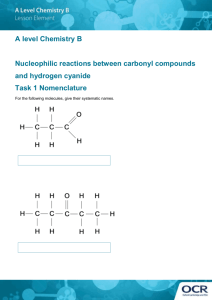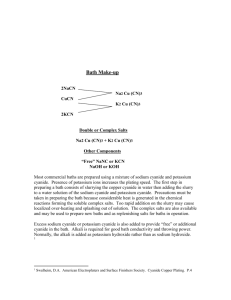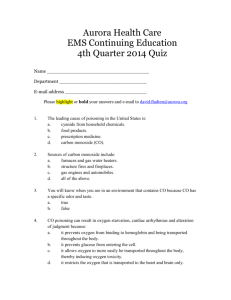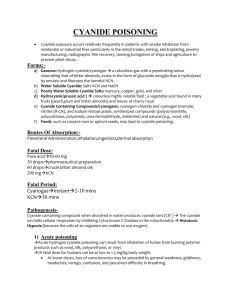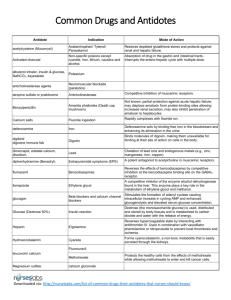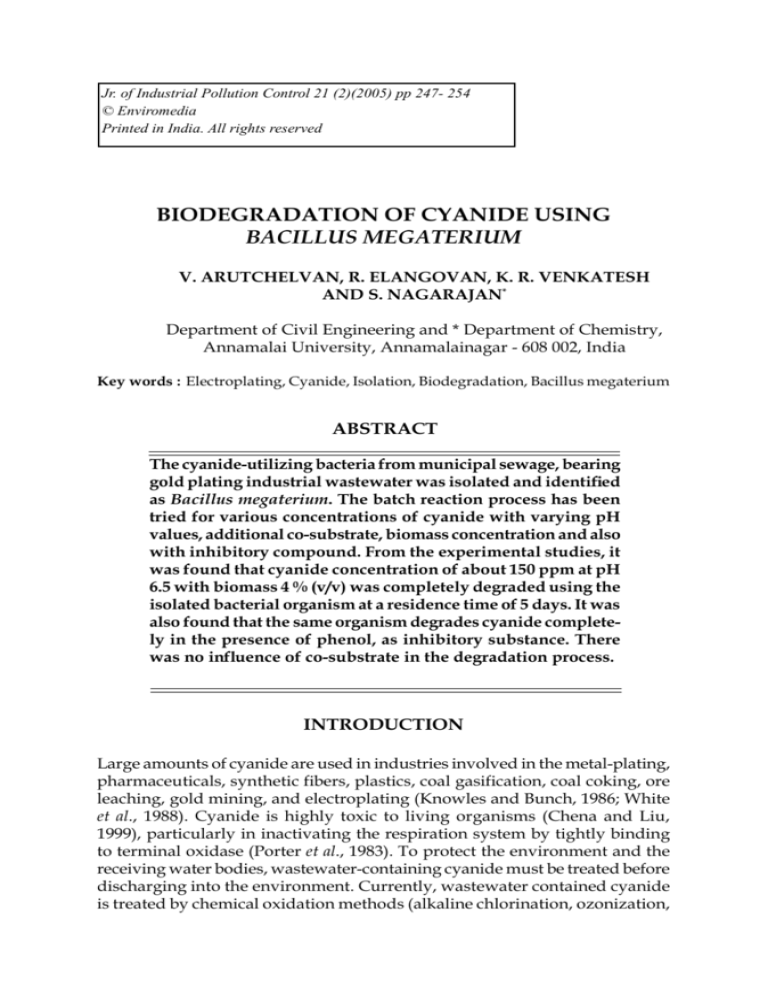
BIODEGRADATION OF CYANIDE USING
247
Jr. of Industrial Pollution Control 21 (2)(2005) pp 247- 254
© Enviromedia
Printed in India. All rights reserved
BIODEGRADATION OF CYANIDE USING
BACILLUS MEGATERIUM
V. ARUTCHELVAN, R. ELANGOVAN, K. R. VENKATESH
AND S. NAGARAJAN*
Department of Civil Engineering and * Department of Chemistry,
Annamalai University, Annamalainagar - 608 002, India
Key words :Electroplating, Cyanide, Isolation, Biodegradation, Bacillus megaterium
ABSTRACT
The cyanide-utilizing bacteria from municipal sewage, bearing
gold plating industrial wastewater was isolated and identified
as Bacillus megaterium. The batch reaction process has been
tried for various concentrations of cyanide with varying pH
values, additional co-substrate, biomass concentration and also
with inhibitory compound. From the experimental studies, it
was found that cyanide concentration of about 150 ppm at pH
6.5 with biomass 4 % (v/v) was completely degraded using the
isolated bacterial organism at a residence time of 5 days. It was
also found that the same organism degrades cyanide completely in the presence of phenol, as inhibitory substance. There
was no influence of co-substrate in the degradation process.
INTRODUCTION
Large amounts of cyanide are used in industries involved in the metal-plating,
pharmaceuticals, synthetic fibers, plastics, coal gasification, coal coking, ore
leaching, gold mining, and electroplating (Knowles and Bunch, 1986; White
et al., 1988). Cyanide is highly toxic to living organisms (Chena and Liu,
1999), particularly in inactivating the respiration system by tightly binding
to terminal oxidase (Porter et al., 1983). To protect the environment and the
receiving water bodies, wastewater-containing cyanide must be treated before
discharging into the environment. Currently, wastewater contained cyanide
is treated by chemical oxidation methods (alkaline chlorination, ozonization,
248
arutchelvan et al.
BIODEGRADATION OF CYANIDE USING
wet-air oxidation) (Palmer et al., 1988; Watanabe et al., 1998). However, these
methods are expensive and hazardous chemicals are used as the reagents
(chlorine and sodium hypochlorite) (Watanabe et al., 1998). Moreover, these
techniques cannot completely degrade all cyanide complexes in many cases
(Figueira et al., 1996). Based on the above discussions, biological treatment
would be a cost-effective and environmentally acceptable method for cyanide
removal compared with the other techniques currently in use (Raybuck, 1992;
Dubey and Holmes, 1995). To develop the biological technology for the treatment of cyanide-containing wastewater, screening of the Cyanide-degrading
microorganisms have been carried out.
tubes containing 9 ml of the minimal medium and supplemented with different concentrations of potassium cyanide (5 to 40 mg/L). The minimal media
used for the isolation of cyanide utilising bacteria contained the following ,
KH2PO4 - 3.3 g/L,K2HPO4 – 4.3 g/L,MgCL2. H2O - 0.3 g/L The medium was
amended with 0.5 ml of the trace elements solution containing the following
(in mg/L) MnCl2 - 1.0; Fe SO4. 7 H2O - 0.8; CaCl2 H2O - 2.4 and Na2 MnO4 .
2H2O - 10.0. The pH was adjusted to 7.0 and the medium was autoclaved. The
minimal medium plates were prepared by adding 15gm of agar to one litre of
the medium.The contents of the tubes were incubated at 25°C. After 6 days of
incubation the inoculum was streaked out on plates containing cyanide as a
sole source. Colonies that grew on the plates were selected for identificaiton
. The morphological and physiological test results show that the organism
isolated from the gold plating industrial wastewater (sediments of Chidambaram town) is gram positive, homogenous, rod shaped Bacillus megaterium.
Most reports described that metabolism of cyanides by strains of Pseudomonas, Acinetobacter, Bacillus, and Alcaligenes (Harris and Knowles, 1983; Finnegan
et al., 1991; Ingvorsen et al., 1991; Meyers et al., 1991). Pseudomonas fluorescens
NCIMB 11764 is able to convert cyanide to ammonia and carbon dioxide via
the action of an oxygenase enzyme which may also proceed by means of NAD
(P)-dependent oxygenase and cyanase (Dorr and Knowles, 1989). Pseudomonas
putida can use cyanide as the nitrogen source and metabolize it to ammonia
(Babu et al., 1996). Kunz et al. (1994) found that P. fluorescens strain NCIMB
degraded cyanide via the activities of several cyanide-degrading enzymes such
as oxygenase, cyanide nitrilase, and cyanide hydratase. Pseudomonas species
degraded cyanide through a pathway where cyanide is converted to ammonium and formate under both aerobic and anaerobic conditions (Watanabe
et al., 1998). Like the cyanide degrading pathway of Pseudomonas, Alcaligenes
xylosoxidans subsp. denitrificans DF3 (Ingvorsen et al., 1991) and Bacillus pumilus
C1 (Meyers et al., 1991) converted cyanide to ammonium and formate via the
activity of cyanidase. In addition, some fungi such as Gloeocerocospora sorghi
(Fry and Munch, 1975; Wang et al., 1992), Fusarium lateritum (Cluness et al.,
1993), and Stemphylium loti (Fry and Millar, 1972) have also been reported to
be able to degrade cyanide.
The present study was aimed to determine the feasibility of Bacillus megaterium, isolated from Chidambaram municipal sewage bearing gold plating
industrial wastewater for cyanide biodegradation under various experimental
conditions.
MATERIAL AND METHOD
The sewage wastewater samples were collected from the gold plating indutrial zones from under-ground drainage in Chidambaram muncipal area viz.,
Chinna chetty street (sampling point I), Gold plating industrial area (sampling point II).The wastewater samples were analysed for various cyanide
concentration as perAPHA (1992) .
Isolation of bacteria
The cyanide contaminated soil and wastewater samples were collected. One
milli litre of the watewater (soil suspension ) was inoculated into sterile test
249
Acclimatized inoculum preparation
About 90 ml of Nitrogen free Glucose (NFG) medium (Na2HPO4.2H2O
[50mM]7.098g/L,KH2PO4 [100 mM]-13.609 g/L, MgSO4.7H2O[ 1 mM]-0.246
g/L, CaCl2[0.1 mM]-0.11 g/L, Dextose[0.8%]-8 g/L) with pH adjusted to
required level was taken and sterilized at 1.5 kg/cm2 gauge pressure for 30
minutes and cooled to room temperature. To this, 1 ml of 1000 ppm cyanide
was added and final volume was adjusted to 100ml in order to get an initial
cyanide substrate concentration 100 ppm. A loop full of the test organism
from the freshly subculture slant was inoculated into the above medium.
The culture was incubated in a shaker at 100 rpm and room temperature
for three days. They formed the Primary culture. The secondary acclimated
inoculum was prepared in the same way wherein 1 ml of primary culture
was used instead of the subculture from slant to inoculate the medium. The
total volume of NFG medium, stock phenol solution and primary culture
was adjusted to set the initial substrate concentration of 100 mg/L .Tertiary
culture was used for batch studies.
Screening of microorganisms
23 flasks of organism, which consists of the original and the duplicate set were
prepared. In each flask about 100 mL of the original and the duplicate were
prepared. In each flask about 100 ml of NFG whose initial pH was adjusted
to 6.5 was taken. All the contents in the flasks were sterilized at 1.5 kg/cm2
gauge pressure for 30 minutes. After cooling to room temperature, 4 %(v/v)
of inoculum and 1 mL of 1000 mg/L cyanide stack were added to get a final
concentration 100 mg/L (except 1-6 flask).In the medium while keeping the
total volume of medium, inoculum and cyanide was 100 mL. Experimental
flask and sterile control were placed on a shaker running at 100 rpm. The flasks
were removed at predetermined time intervals 0 to 12 hours from starting
and the samples were analysed for residual cyanide.
Effect of Initial substrate concentration
To determine the effect of substrate concentration, 1 to 6 flasks with different
250
arutchelvan et al.
BIODEGRADATION OF CYANIDE USING
initial substrate concentration were taken while all other parameters given
previously were kept the same. As before, each run of 6 flasks along with their
duplicate are drawn at predetermined timing. 100 mL medium was added
to each of the flask in the first set and kept for sterilization after adjusting pH
6.5. To each sterilized and cooled flask 4%(v/v) of inoculum was added. The
initial cyanide concentration was maintained by adding 1 mL (1mg) from
the stock solution whose concentration was 1000 mg/L. Similarly, the other
flasks were prepared to a final volume of each 100mL with initial cyanide
concentration of 0, 50,100,150,200 and 250 ppm in the NFG medium along
with 4 %(v/v) of Inoculum.
the substrate inhibition is exhibited. The results of the experiments were given
Fig 1.
It was found that for a cyanide concentration of 50 mg/L, the maximum
degradation was achieved (100%) at a residence time of 3 days. When the
concentration was increased further the degradation process takes more time.
This could be seen from the figure 1 and up to a concentration of 200 mg/L,
100 % degradation was achieved and at concentration of 250 mg/L, the maximum degradation was 97.72 % at a residence time of 6 days. This may be
due to cell lysis, because of the concentration of cyanide can be beyond the
permissible limit at which the organisms cannot survive. A further increase
in concentration would cause a reduction in % degradation. These concentra-
Effect of pH
251
pH ranges from 4.5 to 8.5 were maintained to determine the effect of pH on
degradation of cyanide. 100 ml of NFG medium were prepared at a cyanide
concentration of 150 ppm in different flasks(7-9) with pH ranging 4.5, 5.5, 6.5,
7.5 and 8.5 and all the flasks were subjected to sterilization before adding the
4%(v/v) of inoculums.
Effect of co-substrate
To determine the effect of co-substrate in the degradation process of cyanide,
another 5 nos. of flasks (10-14) were prepared with different 0.4%(v/w),
0.6%(v/w), 0.8%(v/w), 1.0%(v/w) and 1.2%(v/w), of Dextrose as co-substrate. The same NFG medium with pH 6.5 and 4%(v/v)of inoculum was
used for the experiment setup maintaining the initial cyanide concentration
of 150 ppm.
Effect of inoculum size
To study the effect of inoculum variation in degrading the cyanide, another set
of flasks (15-18) were prepared with different inoculum loadings (2 %(v/v),
3 %(v/v), 4 %(v/v), 5 %(v/v), and 6%(v/v)) of the same species adjusted to
a final volume of 100ml of the same medium. The pH of the solution was
maintained at 6.5 and the initial concentration of cyanide as 150 ppm.
Effect of Interference of Phenol
Fig 1 .Effect of initial substrate concentration
tions can only the maximum concentration up to which organism can work.
The pH concentration also plays a major role in the biological activity.
With an increase in pH there was an increase of degradation of cyanide. At
pH of 4.5 the degradation was 92.59 % and for pH 6.5 it was 100 %. As per the
observations made in the batch reaction process it was found that the maximum of 100% degradation was achieved at pH 7.5 and 8.5. From this, it can
be concluded that the organism works well in both the neutral, slightly acidic
and alkaline condition. The results were presented in graphically represented
in Fig 2.
The NFG medium with pH 6.5 taken in each of 5 flasks(19-23). After sterilization and cooling, the contents were inoculated with 4 %(v/v) of culture and
added with 50, 100, 150, 200 & 250 mg/L of phenol concentration. Maintaining
cyanide concentration as 150 mg/L, experiments were carried out.
RESULT AND DISCUSSION
The samples collected from the two sampling points, were analyzed for cyanide concentration and the concentrations at sampling point I and II were
10.5 mg/L and 6350 mg/L respectively.
Degradation of cyanide by Bacillus megaterium with different substrate
concentration (50 to 250 mg/L) was investigated in order to find out whether
Fig 2. Effect of pH
252
arutchelvan et al.
The co-substrate variation was done by varying the dextrose concentration
from 0.4 % (v/w) to1.2 %(v/w). The degradation was attained to a maximum
100 % for 0.4 %(v/w) dextrose concentration at a residence time of 5 days.
When the co-substrate concentration was increased the degradation of 100
% was achieved with increased residence time. Also, at the co-substrate concentration 1.2 %(v/w) the degradation was only 96 %. From this, it can be
concluded that increased co-substrate will inhibit the degradation process.
The details were also presented in Fig.3
BIODEGRADATION OF CYANIDE USING
253
It was found that the with increase of phenol concentration in the cyanide
wastewater the degradation of cyanide reduces due to inhibition of phenol
and the residence time increases with interference of phenol (Fig 5). As per
the observation made during the experiment, it was found that the organism
was more active in degrading the phenol rather degrading the cyanide.
CONCLUSION
Fig 5. Effect of interferences phenol
Fig 3. Effect of co substrate
It was found that the degradation percentage increased when the biomass
concentration was increased. Except for the concentration of 2 %(v/v) all
other concentrations have shown a complete degradation (100%). With an
increase in biomass concentration the residence time have also been reduced
considerably. At a concentration of 6 ml, the residence time was 4.5 days. The
details of the results were also presented graphically in Fig 4.
The isolated and identified species Bacillus megaterium was found to be very
active in degrading the wastewater bearing cyanide. The organism metabolizes
the waste both in acidic and alkaline range, which can be utilized for such type
of wastes. The present study shows that the co-substrate will not have any
significant part in degradation. So in the real plants the cost of co-substrate
can be avoided. It is also observed that there is an increase in the degradation
of cyanide with increase in quantity of inoculum and there is no substantial
effect of inoculum size on the degradation at the completion of degradation
s o that minimum MLSS can be maintained in the bioreactor.
REFERENCES
Fig 4.Effect of inoculums size
APHA, 1992. Standard methods for the examination of water and wastewater APHA, New
York, U.S.A.
Babu, G.R., Vijaya, O.K., Ross, V.L., Wolfram, J.H. and Chapatwala, K.D., 1996.
Cell-free extract(s) of Pseudomonas putida catalyzes the conversion of cyanides,
cyanates,thiocyanates, formamide, and cyanide-containing mine waters into
ammonia. Appl. Microbiol. Biotechnol. (45) : 273-277.
Chena, S.C. and Liu, J.K., 1999. The responses to cyanide of acyanide-resistant Klebsiella
oxytoca bacterial strain. FEMS Microbiol. Lett. (175) : 37-43.
Cluness, M.J., Turner, P.D., Clements, E., Brown, D.T. and O.Reilly, C., 1993. Purification and properties of cyanidehydratase from Fusarium lateritium and analysis
of thecorresponding cby1 gene. J. Gen. Microbiol. (139) : 1807 -1815.
Dorr, P.K. and Knowles, C.J., 1989. Cyanide oxygenase andcyanase activities of Pseudomonas fluorescens NCIMB11764. FEMS Microbiol. Lett. (60) : 289 -294.
Dubey, S.K. and Holmes, D.S., 1995. Biological cyanide destruction mediated by microorganisms.WorldJ. Microbiol.Biotechnol. (11) : 257–265.
254
arutchelvan et al.
Finnegan, I., Toerien, S., Abbot, L., Smit, F. and Raubenheimer, H.G., 1991. Identification and characterization of a Acinetobactersp. capable of assimilation of a
range of cyanometalcomplexes, free cyanide ions and simple organic nitriles.
Appl. Microbiol. Biotechnol. (36) : 142 -144.
Figueira, M.M., Ciminelli, V.S.T., De Andrade, M.C. and Linardi, V.R., 1996. Cyanide
degradation by an Escherichia coli strain. Can. J. Microbiol. (42) : 519 -523.
Fry, W.E. and Millar, R.L., 1972. Cyanide degradation by an enzyme from Stemphylium
loti. Arch. Biochem. Biophys. (151) : 468 -474.
Fry, W.E. and Munch, D.C., 1975. Hydrogen cyanide-detoxification by Gloeocercospora
sorghi. Physiol. Plant Pathol. (7) : 23 -33.
Harris, R.E. and Knowles, C.J., 1983a. Isolation and growth of a Pseudomonas species
that utilized cyanide as a source of nitrogen. J. Gen. Microbiol. (129) : 1005 -1011.
Harris, R.E. and Knowles, C.J., 1983b. The conversion of cyanide to ammonia by extracts of a strain of Pseudomonas fluorescens that utilizes cyanide as a source
of nitrogen. FEMS Microbiol. Lett. (20) : 337 -341.
Ingvorsen, K., Hojer -Pedersen, B. and Godtfredsen, S.E., 1991.Novel cyanide -hydrolyzing enzyme from Alcaligenes xylosoxidans subsp. denitrificans. Appl.
Environ. Microbiol. (57) : 1783 -1789.
Knowles, C.J. and Bunch, A.W., 1986. Microbial cyanide metabolism. Adv. Microb.
Physiol. (27) : 73 -111.
Kunz, D.A., Wang, C.S. and Chen, J.-L., 1994. Alternate routes of enzymic cyanide
metabolism in Pseudomonas fluorescens NCIMB 11764. Microbiology. (140)
1705 - 1712.
Meyers, P.R., Gokool, P., Rawlings, D.E. and Woods, D.R., 1991. An efficient cyanide-degrading Bacillus pumilus strain. J.Gen. Microbiol. (137) : 1397 -1400.
Palmer, S.A.K., Breton, M.A., Nunno, T.J., Sullivan, D.M. and Suprenant, N.F., 1988.
Metal/Cyanide Containing Wastes : Treatment Technologies. Noyes Data,
Park Ridge, NJ.
Porter, N.J., Drozd, W. and Linton, J.D., 1983. The effects of cyanide on the growth
and respiration of Enterobacter aerogens in continuous culture. J. Gen. Microbiol.
(129) : 7 -16.
Raybuck, S.A., 1992. Microbes and microbial enzymes forcyanide degradation. Biodegradation (3) : 3 -18.
Wang, P., Matthews, D.E. and VanEtten, H.D., 1992. Purification and characterization
of cyanide hydratase from phytopathogenic fungus Gloeocercospora sorghi.
Arch. Biochem. Biophys.(298) : 569 -575.
Watanabe, A., Yano, K., Ikebukuro, K. and Karube, I., 1998. Cyanide hydrolysis in
a cyanide-degrading bacterium, Pseudomonas stutzeri AK61, by Cyanidase.
Microbiology. (144) : 1677 -1682.
White, J.M., Jones, D.D., Huang, D. and Gauthier, J.J., 1988. Conversion of cyanide
to formate and ammonia by pseudomonas from industrial wastewater. J. Ind.
Microbiol. (3) : 263 - 272.


